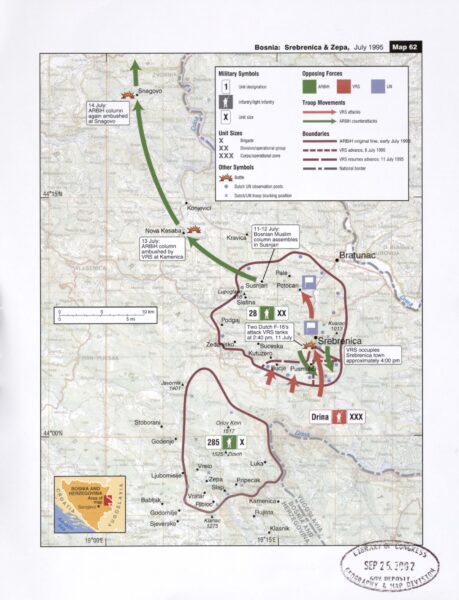Niccolo Soldo’s weekly roundup includes a look at the differences between the story the media told us about the Srebrenica massacre and what has come to light since then:

Map of military operations on July, 1995 against the town of Srebrenica.
Map 61 from Balkan Battlegrounds: A Military History of the Yugoslav Conflict; Map Case (2002) via Wikimedia Commons.
29 years ago this week, Bosnian Serb forces of the VRS managed to seize the town of Srebrenica in Eastern Bosnia, on the border with Serbia. A massacre of Bosnian Muslim males ensued shortly thereafter, and the narrative of genocide sprung forth quickly from it, giving cause to NATO’s intervention in that conflict.
Did a massacre occur? Certainly. Some 2,000 Bosnian Muslim males were summarily executed by Bosnian Serb forces around Srebrenica shortly after the UN-designated “safe haven” fell to the Serbs. Some 8,000 Bosnian Muslims lost their lives in the immediate aftermath of the fall of Srebrenica, but the narrative of “genocide” whereby all 8,000 were executed is simply not true as per John Schindler, the then-Technical Director for the Balkans Division of the NSA:
Twenty-nine years ago today, the Bosnian Serb Army captured Srebrenica, an isolated town in Bosnia’s east that was jam-packed with Bosnian Muslims, most of them refugees. This small offensive, involving only a couple of battalions of Bosnian Serb troops, soon became the biggest story in the world. What happened around Srebrenica in mid-July 1995 permanently changed the West’s approach to war-making and diplomacy.
The essential facts of the Srebrenica massacre are not in dispute. The town was a United Nations “safe area” but U.N. peacekeepers there, an understrength Dutch battalion, failed to protect anyone. Over the week following Srebrenica’s quick fall, some 8,000 Bosnian Muslims, almost all male, a mix of civilians and military personnel, were killed by Bosnian Serb forces. About 2,000 disarmed Bosnian Muslim prisoners of war were executed soon after the town’s capture. The rest died in the days that followed, all over eastern Bosnia.
As the world learned the extent of the massacre, by far the biggest atrocity in the Bosnian War that had raged since the spring of 1992, Western anger mounted. Six weeks later, President Bill Clinton ordered the Pentagon to bomb the Bosnian Serbs in Operation Deliberate Force, the first major military action in NATO’s history. By the year’s end, the war was concluded by American-led diplomacy.
Here are Schindler’s conclusions:
That for three years, Srebrenica, supposedly a U.N. “safe area,” served as a staging base for Bosnian Muslim attacks into Serb territory. The Muslim military’s 28th Division regularly attacked out of Srebrenica. Bosnian Serbs claim they lost over 3,000 people, civilian and military, to those attacks.
That the Bosnian Muslim commander at Srebrenica, Naser Oric, was a thug who tortured and killed Serb civilians (he showed Western journalists footage of his troops decapitating Serb prisoners), as well as fellow Muslims he disliked. Mysteriously, Oric fled Srebrenica three months before the town’s fall, leaving his troops to die.
That most of the Bosnian Muslim dead, some three-quarters of them, died not at Srebrenica but during an attempted breakout by troops of the 28th Division to reach their own lines around Tuzla. They showed little communications discipline, and Bosnian Serb forces called down their artillery on them, columns of Muslim military and civilians together, slaughtering them. This doesn’t meet any standard definition of genocide.
That the Muslims were flying weapons into the “safe area” by helicopter in the months before the Bosnian Serb offensive. (Controversially, the Pentagon knew this was happening but pretended it didn’t.) The Serbs repeatedly protested to the U.N. about this violation, to no avail. This was the reason for the offensive to take the town.
There’s also convincing evidence that the Muslim leadership in Sarajevo knew Srebrenica would be attacked and allowed it to fall. Their leader, Alija Izetbegovic, stated that if Srebrenica fell, the Serbs would massacre Muslims as payback, and America would intervene on the Muslim side in the war. He was right.
Some of you may not like what John has to say here about Gaza and how it relates to Srebrenica:
This isn’t merely a historical matter. What happened in Bosnia is being repeated today in Gaza. Western journalists uncritically accept Muslim claims about war crimes and “genocide” to smear a Western state that’s at war with radical Islam.
Here the strange ideological affinity between jihadists and the Western Left plays a role, as it did during the Bosnian War as well. No claims of war crimes, which possess great political value on the world stage, should be accepted without independent confirmation. Srebrenica should have taught Western elites this essential truth, but it didn’t.
On a personal note, I like to bring up Srebrenica to Serbs as an example of how media shapes narratives that are often very remote from the truth in the hope that they understand what I am saying in a wider context.
Fun fact: Srebrenica translates into “Silverton”, as it was a significant silver mining town during the late Medieval era, with imported Saxons running the show.



